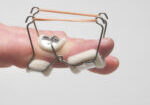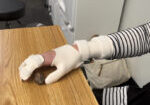“Do joint mobilizations assist in the recovery of lateral elbow tendinopathy? A systematic review and meta-analysis”
Filed under Treatments
By Sophia Grimm
Lucado, A. M., Dale, R. B., Vincent, J., & Day, J. M. (2019). Do joint mobilizations assist in the recovery of lateral elbow tendinopathy? A systematic review and meta-analysis. Journal of hand therapy : official journal of the American Society of Hand Therapists, 32(2), 262–276.e1. https://doi.org/10.1016/j.jht.2018.01.010
The Skinny:
The purpose of this study was to determine if joint mobilizations are effective in improving pain, grip strength, and disability in adults with lateral elbow tendinopathy (LET). LET is a degenerative tendon pathology that is a prevalent condition in manual workers, middle-aged adults ages 45-54, and athletes with a prevalence reported as high as 12.2% in the at-risk population. The study tested three types of joint mobilizations. The first joint mobilization, mobilization with movement (MWM) technique, consists of a lateral glide where the therapist glides the proximal forearm laterally and sustains it. At the same time, the distal end of the humerus is fixed on the other hand. This is performed while the patient performs a pain-free gripping action for 6 repetitions with 15 second rest periods. Mill’s manipulation was also included in this study and is performed by internally rotating and abducting the shoulder so that the olecranon faces the ceiling. The therapist holds the patient’s wrist in full flexion and forearm in pronation and then applies a high-velocity low-amplitude thrust at the elbow’s end range in extension. Lastly, this study included regional mobilization techniques to the cervical spine. This included rotational high-velocity, low-amplitude thrust manipulation of C5-6, grade 3 slide glides of C5-6, and grade 3 or 4 passive accessory intervertebral movements of cervical and thoracic segments.
In the Weeds:
This systematic review included a total of 7 studies in the meta-analysis. Inclusion criteria consisted of control trial studies of adults with a clinical diagnosis of LET. For this systematic review, researchers classified three joint mobilization techniques: mobilization with movement (MWM), Mill’s manipulation, and regional mobilization techniques. A standardized set of data was extracted for all selected studies. The summary data were considered statistically significant if the 95% confidence interval (CI) did not include 0. Following data comparisons, researchers found that MWM demonstrated a mean effect size of 0.43 (95% confidence interval [CI]: 0.15-0.71) for improving pain rating and 0.31 (95% CI: 0.11-0.51) for improvements in grip strength. The study also found that Mill’s manipulation had a mean effect size of 0.01 (95% CI: 0.27 to 0.26) for grip strength and 0.47 (95% CI: 0.11-0.82) for pain rating.
Bringing it Home:
There is compelling evidence that joint mobilizations directed at the elbow improve both pain and functional grip scores. Pain, grip strength, and functional outcomes were improved with regional mobilizations. The data from this meta-analysis demonstrated moderate effect sizes in favor of both Mill’s manipulation and MWM on patients with LET. LET. Given this study’s outcomes, the authors can confidently recommend mobilization as a treatment for LET in the immediate, short, and intermediate terms before symptoms become chronic.
Rating: 5/5
This systematic review and meta-analysis are very well done. The researchers had clear inclusion and exclusion criteria to identify suitable studies for drawing proper comparisons and conclusions. During the study selection process, all titles and abstracts were reviewed by two reviewers to ensure relevance to the topic. This study’s greatest limitation was that no true control group existed for many of the studies included in this review. Most studies varied significantly in set-up and data collection.
3 Comments
Leave a Comment
More To Read
Management of the Stiff Finger: Evidence and Outcomes
Title: Management of the Stiff Finger: Evidence and Outcomes Reference: Yang, G., McGlinn, E. P., & Chung, K. C. (2014). Management of the stiff finger: Evidence and outcomes. Clinics in Plastic Surgery, 41(3), 501–512. https://doi.org/10.1016/j.cps.2014.03.011 Article Review By: Tommi Hintnaus The Skinny: This study focuses on understanding and managing finger stiffness, a condition characterized by…
Read MoreVideo-augmented mirror therapy for upper extremity rehabilitation after stroke
Kim, H., Kim, J., Jo, S., Lee, K., Kim, J., & Song, C. (2023). Video augmented mirror therapy for upper extremity rehabilitation after stroke: a randomized controlled trial. Journal of Neurology, 270(2), 831-842. Article Review: Shannon Skowbo The Skinny: This single-blind, randomized control trial aimed to assess the effects of mirror therapy for stroke patients…
Read MoreWhat to Know as a Hand Therapist When Choosing Thermoplastic Orthosis Material
By: Kelsey Melton Thermoplastic materials can have a variety of properties. Each supplier has a different version of each combination of variables for the therapist to choose from. The most common brands used for orthosis fabrication are Orfit, NorthCoast Medical (NCM), and Raylan. These brands all have their versions of thermoplastic material that vary in…
Read MoreGraded Motor Imagery in Hand Therapy
The 3 Stages of Graded Motor Imagery We’ve all heard of mirror box therapy, but do you know the details of how it works? There’s actually 3 stages involved that exercise the brain and take advantage of its plasticity. There is a great deal of evidence supporting these three stages and you can use them…
Read MoreSign-up to Get Updates Straight to Your Inbox!
Sign up with us and we will send you regular blog posts on everything hand therapy, notices every time we upload new videos and tutorials, along with handout, protocols, and other useful information.







I wish you would’ve included a video demonstration
Would love to see a video as well.
“can confidently recommend mobilization as a treatment for LET in the immediate, short, and intermediate terms before symptoms become chronic”
Unfortunately how often does one get a patient in a non chronic state? Not very often. As a profession we need to get beyond the holy grail search for the “best” passive intervention. We need to talk to tendons in their language, not ours, we need to give it what it needs, load.